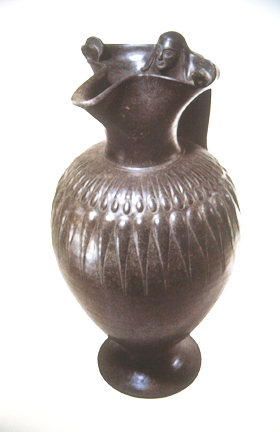
Bucchero Ware Pitcher, Etruscan
600-500 BCE, Italian peninsula, 18" ht.
ART 198 - HISTORY OF WORLD CERAMICS
| The Etruscans followed the Villanovans in the same region of northern Italy around 700 BCE, and absorbed many aspects of their culture and pottery making techniques. They were skilled metalworkers whose bronze work was widely exported in the Mediterranean region. This example is of Bucchero ware, the most distinctive of the Etruscan pottery styles. Bucchero ware is recognizable by the gray-black color of the clay, achieved by reduction firing in an atmosphere of carbon dioxide, turning the red clay to gray or black. Other distinguishing characteristics of Bucchero ware are: 1) the surface is burnished to a high sheen, 2) shapes are inspired by metalwork and, 3) decoration is usually continuous bands or friezes of relief, often zoomorphic sphinxes similar to that seen in the 'orientalized' early Greek black figure ware. Here, however, a delicately modeled human face adorns the junction of the handle with the pitcher. The modeling of the face recalls archaic Greek sculpture, where the faces often have the slight smile. The spouts on Bucchero ware pitchers are very different from the Greek. Note the unique shape of the spout on this and the next Etruscan pitcher. The embossed (raised) designs seen here are clearly reminiscent of metal work. | Bucchero Ware Pitcher, Etruscan 600-500 BCE, Italian peninsula, 18" ht. |
|
|